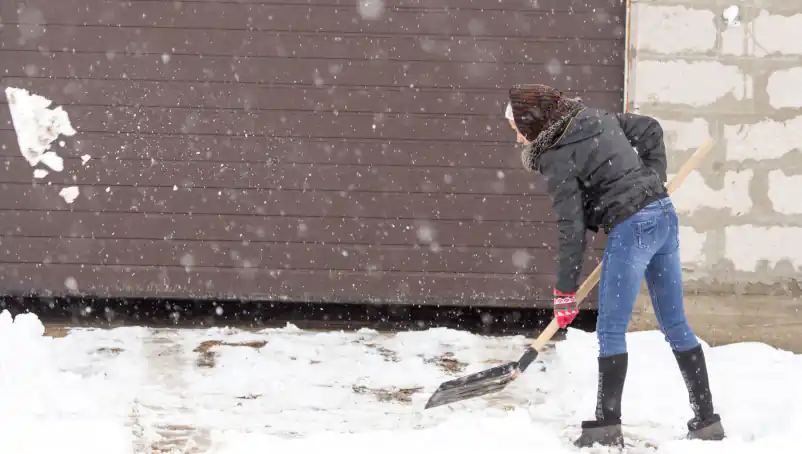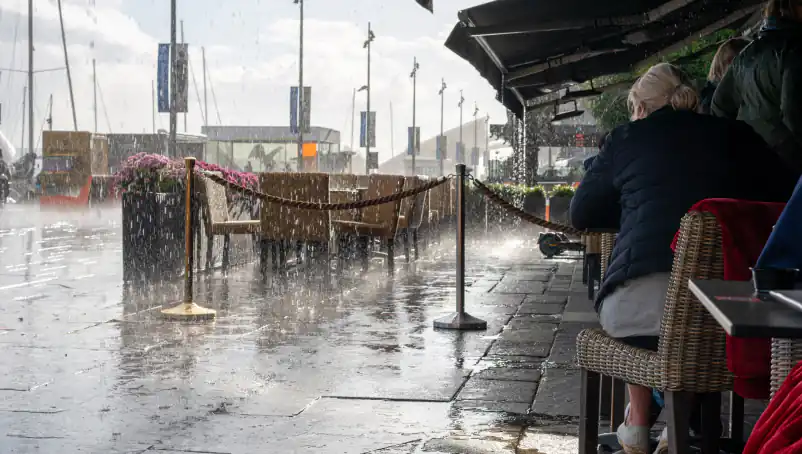11 tips to protect your business for cold weather safety
NEXT helps keep 1,300+ types of small businesses nationwide safe from a wide range of events that can threaten a business, including winter weather.
As a small business insurer, we receive many winter-related insurance claims, but these are some of the most common we see for the season:
- Fire sprinkler pipes bursting and leaking water.
- Boiler or HVAC failure.
- Roof damage caused by ice.
- Burst water pipes.
- A small issue, such as a leak, was not detected immediately (due to holidays or breaks during cold weather) and caused more damage than it should have. Prevention is key. Maintain your property before snow, ice and freezing temperatures arrive to lessen your chance of winter damage.
Prepare your business before the first frost with these essential projects.
1. Inspect and repair your roof
Inspect your roof for any damage or weak spots that could lead to leaks or collapses under the weight of heavy snow. Address any issues promptly to avoid costly repairs later on.
2. Protect outdoor equipment and structures
Move outdoor equipment, furniture and inventory indoors or cover them securely to shield them from harsh winter conditions.
Disconnect hoses and store them inside. If you have outdoor fixtures, you can shut off the spigot’s water supply, drain the remaining water from the faucet and pipe and cover the faucet with a cover.
3. Clear gutters and downspouts to prevent ice dams
Clear roof drainage of debris to ensure proper water flow. This will help prevent ice dams from forming, which can cause water to seep into your building. (Ice dams form when heavy snow melts during the day and then refreezes when temperatures drop overnight.)
4. Clear snow and ice from walkways and parking lots
While this action is more reactive than proactive, it’s a best practice nonetheless. Regularly remove snow and ice from pathways to prevent slip-and-fall injuries. Lay moisture-absorbent floor mats both inside and outside your entryway to help prevent slippery water on the ground.
Invest in snow shovels, ice melt or hire a snow removal service if necessary. If you have a snow blower, keep it gassed up and ready for use.
When there’s snow cover outdoors, clearly mark all access ways and obstacles with flags, such as fire hydrants, parking stops, etc. Make them extra visible to help ensure no one causes damage to their vehicles or themselves.
5. Insulate pipes and water lines
Insulate exposed pipes and water lines to prevent freezing and potential bursts. Use pipe insulation sleeves or heat tape to protect vulnerable areas.
Keep faucets dripping during extreme freezing temperatures. Even a small amount of water running through the pipe will help keep it from freezing.
6. Set up a leak detector system
The longer a leak goes undiscovered, the more damage it can cause to furniture and equipment. Leaks can generate mildew and fungi and jeopardize structural stability.
A water leak detector/system can lessen the danger by alerting you to problems promptly, allowing you to take action to prevent serious harm.
7. Maintain heating systems
Schedule regular maintenance for your heating and HVAC systems to ensure they function optimally during the winter season. Clean or replace filters, check thermostats and bleed radiators if necessary. Maintain temperature above 55 degrees Fahrenheit.
While portable electric space heaters are a popular heat source in too-cold offices, they can pose a fire and electrical hazard if placed near combustible or flammable items. If you do use portable heaters at work, verify that they’re UL listed.
8. Seal drafts and air leaks
Identify and seal any drafts or air leaks around windows, doors and other openings with weather stripping or caulking. This will help maintain a comfortable temperature inside and reduce energy costs.
9. Protect sensitive equipment
Cold temperatures and wind chill can harm sensitive equipment and lead to equipment breakdown — which always seems to happen at the worst time. Ensure your tools and machinery are stored in temperature-controlled areas or use protective covers to shield them from extreme temperature fluctuations.
10. Monitor your carbon monoxide levels
Check the batteries in your smoke detectors and carbon monoxide detectors as part of your winterization plans. Carbon monoxide poisoning and exposure can occur more during the fall and winter when people increase the use of gas furnaces and heaters.
11. Protect employees working outdoors
If employees work outdoors or in poorly heated spaces (such as a warehouse), they could be at risk for hypothermia or frostbite. Make certain that all employees, particularly older adults, have proper warm and waterproof clothing to help them perform at work. Ensure that they are able to take breaks somewhere warm.
Insurance protection for winter weather incidents
To ensure that you have adequate insurance coverage for cold weather events, be sure to:
- Review your insurance policy. Carefully read your policy to understand what is covered and what is not. Pay attention to deductibles, exclusions and coverage limits.
- Update your policy if necessary. If your business has undergone changes, gained or lost employees or acquired new equipment, update your policy to reflect your business’s current value and risks.
Commercial property insurance can help mitigate financial loss during winter-related incidents. This coverage can help protect your building structure and the physical assets you need to operate your business, such as fixtures, furniture and inventory.
Commercial property coverage can also help protect you against business income loss and related expenses if you need to temporarily close your business for repairs after a covered event.
If you don’t own the property you use for business, business personal property insurance can also help to cover the goods and gear you need for your business.
Emergency planning: 5 ways to prepare your business for winter storms
If you live in an area that can get extreme winter weather such as storms, blizzards, deep snowfall and the like, you need to prepare for events like a power outage or getting snowed in.
1. Identify emergency contacts and resources
Make a list of emergency contacts, including local authorities, utility companies and your insurance provider. Keep this information readily accessible in case of emergencies.
(NEXT customers can always contact us via our website, mobile app or virtual assistant.)
2. Create a winter weather emergency kit
Assemble an emergency first-aid kit that includes essentials like flashlights, extra batteries, blankets, first aid supplies, spare cell phone portable batteries and chargers, water and non-perishable food. The quantity of your kit should be enough to sustain the number of employees working a typical shift.
Winter emergency supplies might also include extra warm clothing, hand and foot warming packs, ice scrapers or foldable shovels, and a fire starter or striker.
3. Establish communication protocols with employees
Develop a communication plan to keep your employees informed during severe weather conditions. Utilize phone trees, group messaging apps or other reliable methods to stay connected.
You’ll also want to let customers know if and when you’re closing. If you will be closing early due to a winter storm or blizzard, or not opening at all, use social media channels to relay that information. If you have a storefront, post a sign notifying your customers of your closing.
4. Create a business continuity plan
A business continuity plan lists the most critical business processes and how to keep them running smoothly if something goes wrong.
What will happen if roads are closed and you can’t make deliveries? What’s your backup plan if you pay vendors or employees via check but the banks are closed? If possible, identify an alternative location for your products to be manufactured or sold if you lose your workspace for an extended period of time.
Train your employees on emergency procedures for your business. Ensure they know how to respond in different scenarios, such as evacuations, building damage or turning off water or electricity for the building.
5. Buy a generator
Depending on your business, an electric or battery-powered generator might be necessary for equipment, devices, or products requiring electricity, such as walk-in refrigerators or substances that require temperature or humidity control. Remember that you can’t operate most generators indoors due to their carbon monoxide production. If you plan to buy a generator, you’ll need a safe and outdoor space to keep it out of wet weather and high winds.






